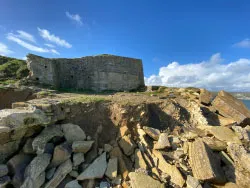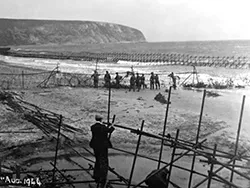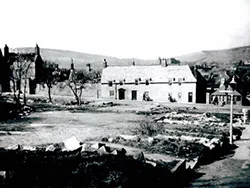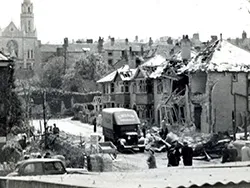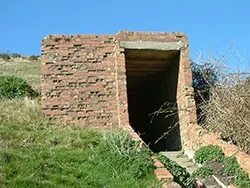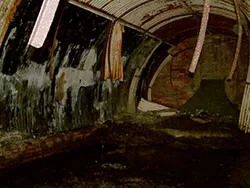
World War 2 in Purbeck in Education resources
Overview
The Second World War affected the Isle of Purbeck in several ways. The military took over parts of the area for training exercises, and attacks by the German Luftwaffe destroyed houses in Swanage, killing 20 people and injuring many more. Observation posts were built along the coast with gun emplacements installed at Peveril Point and Ballard Down.
Ballard Down Obelisk was dismantled in 1940 as it was feared that German pilots could use it as a navigation aid. The obelisk was rebuilt in 1973 but at a shorter height than it originally stood, with one section left alongside the main structure.
Concrete pillboxes containing machine guns were installed in Studland Bay and Swanage Bay at the northern end below Ballard Down and on the southern shore between the Pier and Peveril Point.
All of the beaches in Purbeck were covered with concrete blocks known as dragon’s teeth. These square-pyramidal fortifications were designed to slow the movement of tanks and mechanised infantry in the event of a German invasion. Over 5000 mines were laid on the beaches in Purbeck.
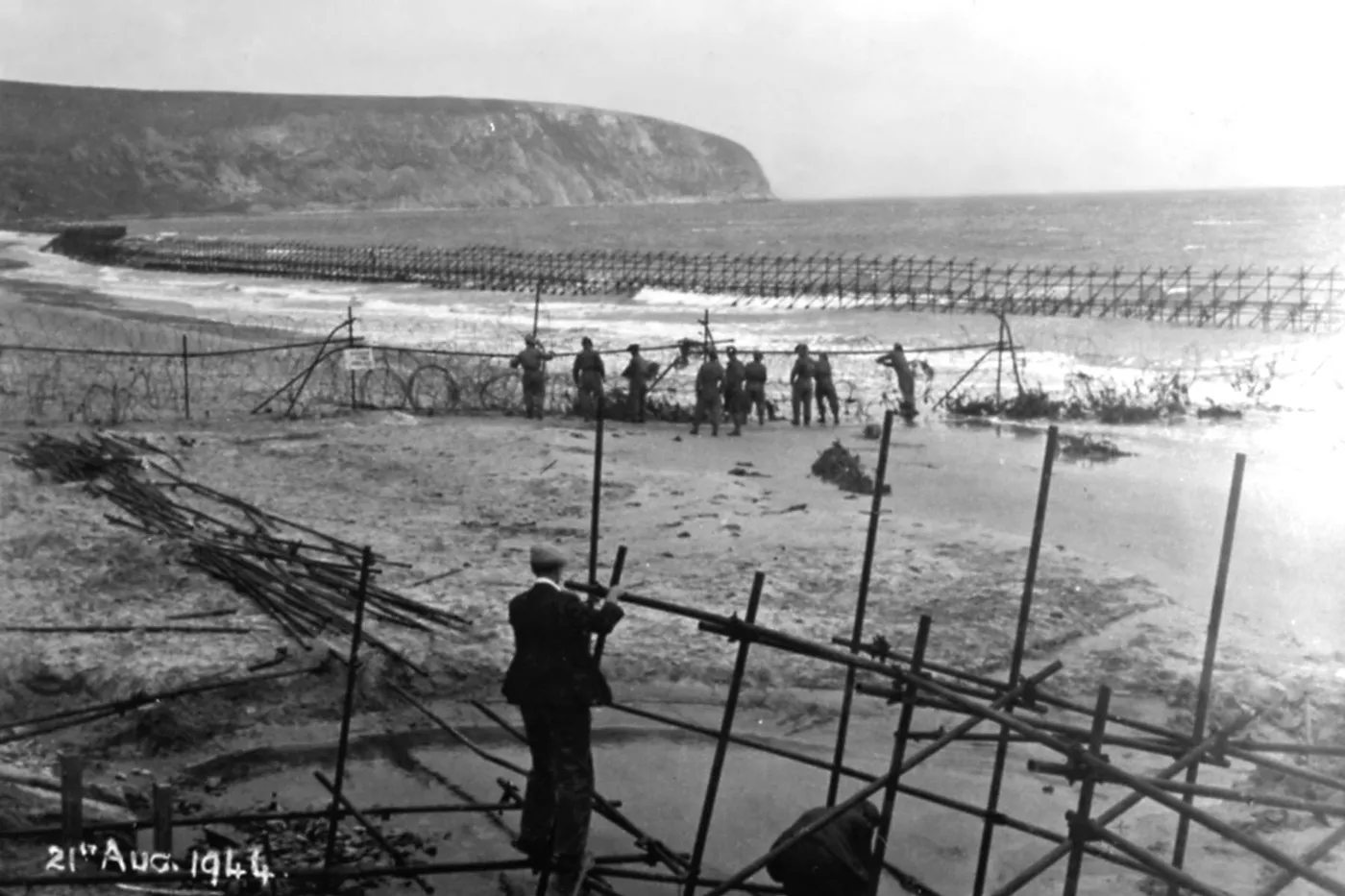
Air Raids
The German Luftwaffe attacked Swanage on several occasions during World War 2, with most of the attacks being carried out in 1942. The bombing was carried out mainly by light bombers such as the Junkers Ju 87 Stuka and Messerschmitt Bf 109 fighter. In total, Swanage had more air raid alerts than London and suffered a total of 20 deaths. The major attacks on the town are listed below.
20th April 1942
An attack on the centre of Swanage damaged houses on Cornwall Road and commercial buildings on Station Road.
13th July 1942
An attack on Park Road injured three people and damaged houses.
14th May 1942
Wesley’s Cottage in the High Street was damaged by a bomb. The cottage was named after John Wesley, who founded Methodism. He visited the town in 1774, 1776 and 1787.
17th August 1942
Just before 11 am, German Focke-Wulf 190s flew in over the headland at Old Harry Rocks and headed across towards the centre of town, firing their machine guns at people on the beach. The attack on the town resulted in a direct hit on the Westminster Bank on Institute Road, killing the manager and his wife. A photographic studio and café were also badly damaged. Eight people were killed, and thirty-nine were wounded in the attack. Bombs were also dropped on Chapel Lane, Church Hill and the Narrows in the High Street, a short distance from the Town Hall. The houses in the High Street were demolished, and Swanage Day Centre was built in their place.
23rd August 1942
Five people were killed and nine wounded in an attack on the town centre. Commercial buildings around the Square, including the Ship, were damaged.
Exercise Smash
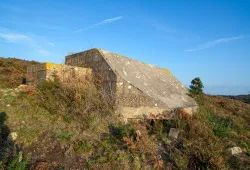
During the run-up to D-Day, a place was needed to rehearse the invasion. Studland beach was chosen as it resembled the beaches in France where the real action would take place; the operation was named Exercise Smash.
During April 1944, British infantry, including the 1st Battalion of the Dorsetshire Regiment, used amphibious craft to land on Studland beach. Live ammunition was used to create a strong sense of realism for those involved. Aerial attacks were carried out by British and American aircraft dropping bombs and firing rockets at Studland Heath while cruiser and destroyer ships bombarded the area from offshore. Semi-submersible tanks were used during the attack, several of which sank and still sat on the bottom of Studland Bay. A crew of six men drowned when their Valentine semi-submersible tank sunk.
Several bunkers and observation posts were built during the run-up to Exercise Smash, and many of them can still be found on Studland Heath buried in the gorse and heather. The largest observation post was Fort Henry which overlooks Studland Bay from the top of the hill in front of the Manor House Hotel. Fort Henry was the largest and strongest observation post to be built in Britain. It was used by several VIPs, including King George VI, Prime Minister Winston Churchill and General Eisenhower (supreme commander of the allied forces).
Radar Development in Purbeck
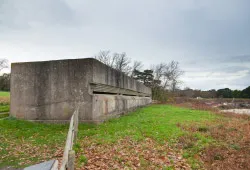 The Isle of Purbeck played a large role in the development of aircraft detecting radar during World War 2. In May 1940, a radar development station was built on the cliff top near Worth Matravers. The installation was used to test new ideas in radar development, and a 110-metre tower was built to broadcast radar signals.
The Isle of Purbeck played a large role in the development of aircraft detecting radar during World War 2. In May 1940, a radar development station was built on the cliff top near Worth Matravers. The installation was used to test new ideas in radar development, and a 110-metre tower was built to broadcast radar signals.
The radar station was used for development until May 1942, when the work was moved inland to Malvern, but the RAF continued to operate the radar at Worth for several years after the war. The radar tower was taken down in the early 1970s, and all left today is a monument at St Aldhelms Head near the coastguard lookout.
At its peak, around 2000 people worked at the station.
Tyneham
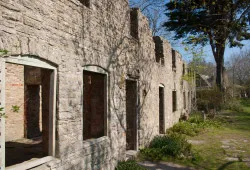 Tyneham is a small village in west Purbeck about 10 miles west of Swanage. The village dated back before medieval times and was a small thriving community with a Parish covering 3000 acres. On the 17th of November 1943, the village and surrounding farmland were commandeered by the War Office for use as a firing range for training troops. Two hundred fifty-two people left their homes with the hope that they would be able to return after the war, but in 1948 the army placed a compulsory purchase order on the land, and it remains to this day as a military training area.
Tyneham is a small village in west Purbeck about 10 miles west of Swanage. The village dated back before medieval times and was a small thriving community with a Parish covering 3000 acres. On the 17th of November 1943, the village and surrounding farmland were commandeered by the War Office for use as a firing range for training troops. Two hundred fifty-two people left their homes with the hope that they would be able to return after the war, but in 1948 the army placed a compulsory purchase order on the land, and it remains to this day as a military training area.
Events after the War
After World War 2, Swanage and the surrounding area tried to rebuild itself, but like many seaside towns, it was hit hard by the recession that followed the war. Many of the houses in the town were severely damaged and needed to be rebuilt. Mines were removed from the beaches, but there were thousands of unexploded bombs and bullets left in the surrounding countryside and heathland, many of which are still being found today. Most of the observation posts were dismantled, but a few can still be found along the beaches in Studland and Swanage and across Studland Heath, the largest of which Fort Henry can be accessed from the footpath south of Middle Beach car park in Studland.
